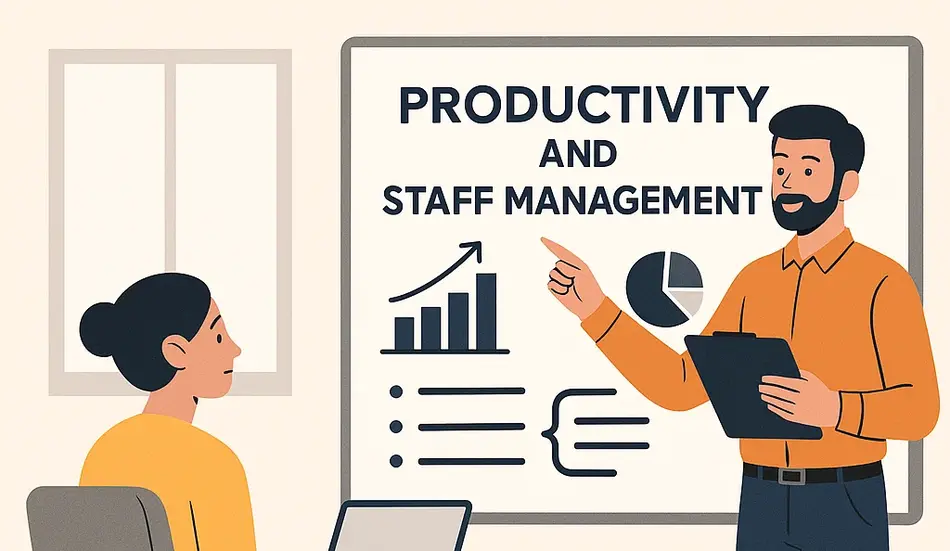Effective productivity and staff management is the cornerstone of any successful organisation. In today’s evolving work environment, leaders must adapt to hybrid setups, shifting employee expectations, and rising performance benchmarks. Whether you’re leading a small team or managing a large workforce, mastering this skill can significantly impact morale, output, and business growth. This guide explores actionable strategies to help you manage your staff efficiently while enhancing workplace productivity.
Table of Contents
Introduction: Why Productivity and Staff Management Matters
Productivity directly correlates with organisational success. When staff are engaged and aligned with business goals, they contribute more effectively. However, productivity isn’t just about doing more in less time—it’s about working smarter, eliminating inefficiencies, and maintaining sustainable performance levels. Good staff management ensures that people feel supported, challenged, and empowered.
Step-by-Step Guide to Boosting Staff Productivity
1. Set Clear and Measurable Goals
Clearly defined goals keep teams focused. Use SMART objectives and ensure each employee understands how their contributions support wider company outcomes.
Tip: Hold monthly goal-setting meetings and use platforms like Asana or Trello to maintain visibility.
2. Foster a Culture of Accountability
Accountability ensures responsibility is shared. Assign tasks with deadlines and encourage ownership of results. Regular feedback loops are essential.
Example: Weekly check-ins or stand-up meetings reinforce team-wide commitment and offer opportunities for course correction.
3. Invest in the Right Tools and Training
Outdated tools slow productivity. Equip your team with project management software, time trackers, and performance dashboards. Provide ongoing training to keep skills sharp.
Tools to try: Slack, Microsoft Teams, Notion, and LinkedIn Learning.
4. Encourage Flexible Working and Work-Life Balance
Trust and autonomy go hand in hand. Offering flexible hours or hybrid options helps reduce burnout and boost employee satisfaction.
Strategy: Adopt a results-oriented mindset—focus on outcomes, not hours.
5. Track Progress and Adjust as Needed
Monitor KPIs and gather team feedback regularly. Be ready to pivot your approach when necessary based on data and employee sentiment.
Framework: Try using OKRs (Objectives and Key Results) to align daily activities with strategic goals.

Common Pitfalls to Avoid in Staff Management
- Micromanagement: Undermines trust and stifles creativity.
- Lack of feedback: Staff can’t grow without constructive, timely input.
- Poor communication: Leads to misunderstandings, missed deadlines, and disengagement.
- Inflexibility: Not adapting to individual needs or circumstances may increase turnover.
Real-World Examples and Case Studies
- Microsoft UK: Boosted team output by introducing flexible working and removing mandatory core hours.
- Monzo Bank: Focuses heavily on asynchronous communication to support productivity across distributed teams.
- Unilever: Implements a “Results-Only Work Environment” that prioritises output over hours worked.
Tools and Resources to Support Your Strategy
- 15Five: For weekly employee check-ins and performance tracking.
- Clockify: Time tracking and productivity analysis.
- Harvard Business Review: Research-backed articles on productivity trends and leadership.
- Google Workspace: Collaboration tools to streamline communication and documentation.
Conclusion and Next Steps
Improving productivity and staff management isn’t a one-time initiative—it’s a continuous process. By setting clear goals, using the right tools, encouraging flexibility, and fostering accountability, you lay the groundwork for a high-performing team. Ready to unlock your team’s full potential? Explore more insights on our Career Advice Hub and begin transforming your workplace today
Frequently Asked Questions (FAQ)
Q1: How can I improve staff productivity?
Improve staff productivity by setting clear goals, providing the right tools, encouraging accountability, and offering flexibility. Use platforms like Asana or Slack to streamline tasks and communication. Regular feedback and recognition also keep employees engaged and motivated.
Q2: What are the best strategies for managing staff effectively?
Top strategies include clear communication, performance monitoring, staff development, and a focus on results over hours. Incorporating frameworks like OKRs (Objectives and Key Results) aligns personal performance with company goals and promotes a results-driven culture.
Q3: What tools help boost team productivity?
Tools such as 15Five, Clockify, Notion, and Google Workspace are excellent for time tracking, feedback, task management, and collaboration. These platforms support transparency and reduce inefficiencies.
Q4: How do flexible work policies impact productivity?
Flexible policies increase employee satisfaction and reduce burnout, which directly enhances productivity. Case studies from Unilever and Microsoft show that focusing on output rather than rigid schedules leads to better performance and higher retention.






